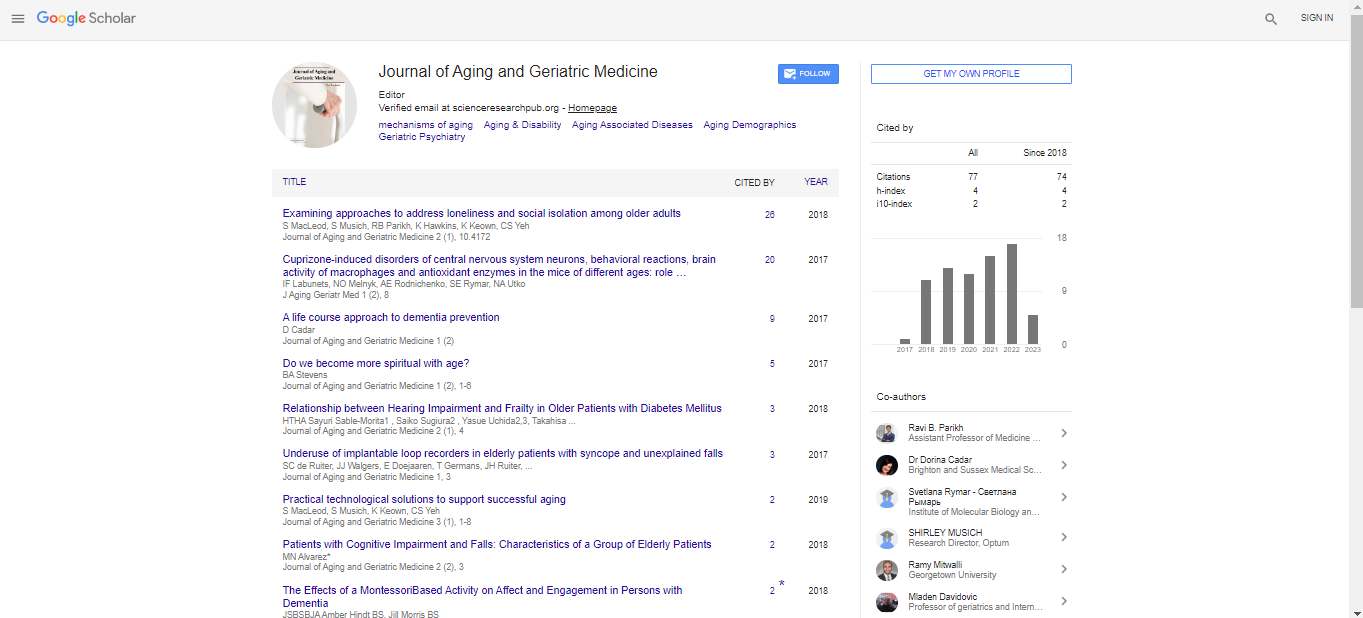Perspective, J Aging Geriatr Med Vol: 6 Issue: 2
A Therapy for Age-Related Diseases
Blagosklonny Seffy*
Department of Cell Stress Biology, Roswell Park Cancer Institute, Buffalo, New York, USA
*Corresponding author: Blagosklonny Seffy, Department of Cell Stress Biology, Roswell Park Cancer Institute, Buffalo, New York, USA, E-mail: Blagosklonny@gmail.com
Received date: 21 January, 2022, Manuscript No. AGM-22-60347;
Editor assigned date: 23 January, 2022, PreQC No. AGM-22-60347 (PQ);
Reviewed date: 06 February, 2022, QC No AGM-22-60347;
Revised date: 11 February, 2022, Manuscript No. AGM-22-60347 (R);
Published date: 21 February, 2022, DOI: 10.4172/2576-3946.1000128.
Citation: Seffy B (2022) A Therapy for Age-Related Diseases. J Aging Geriatr Med Vol.6 No.2:128
Abstract
Atherosclerosis, hypertension, rotundity, diabetic complications, cancer, benign prostate hyperplasia, Alzheimer and Parkinson conditions, age- related macular degeneration, osteoarthritis, osteoporosis, and seborrheic keratosis are explosively associated with aging, inferring a common beginning process. Each complaint is treated independently and, in utmost cases, symptomatically. Repression of growing itself should delay or treat all age- related conditions, therefore adding healthy life span and minimal life. But, is it possible to decelerate down aging? Recent substantiation indicates that the target of rapamycin signaling pathway is involved in cellular anility and organismal aging. Preclinical and clinical studies demonstrated the remedial goods of rapamycin in different age- related conditions. One simple reason why a single medicine is indicated for so numerous age- related conditions is that it inhibits the aging process.
Keywords: Atherosclerosis
Description
Atherosclerosis, hypertension, rotundity, diabetic complications, cancer, benign prostate hyperplasia, Alzheimer and Parkinson conditions, age- related macular degeneration, osteoarthritis, osteoporosis, and seborrheic keratosis are explosively associated with aging, inferring a common beginning process. Each complaint is treated independently and, in utmost cases, symptomatically. Repression of growing itself should delay or treat all age- related conditions, therefore adding healthy life span and minimal life. But, is it possible to decelerate down aging? Recent substantiation indicates that the target of rapamycin signaling pathway is involved in cellular anility and organismal aging. Preclinical and clinical studies demonstrated the remedial goods of rapamycin in different age- related conditions. One simple reason why a single medicine is indicated for so numerous age- related conditions is that it inhibits the aging process.
mTOR and Geroconversion
Humans and other mammals frequently die from age- related conditions, similar as cancer, ischemic heart complaint, hypertension, stroke, and complications of osteoporosis, type 2 diabetes mellitus, and Alzheimer and Parkinson conditions. Each complaint is treated independently, for illustration, diabetes is generally treated with insulin. Still, insulin doesn't treat cancer; rather, it stimulates cancer. Likewise, insulin promotes rotundity and atherosclerosis, and insulin remedy likely worsens retinopathy. In addition, insulin- actuated pathways promote aging. Thus, while compensating for insulin insufficiency and insulin resistance in diabetes, insulin remedy may accelerate aging. Also, while treating cancer, radiation doesn't treat diabetes and other age- related conditions, if cancer were to be cured, other conditions would continue to limit life span. To help age- related conditions and, thus, to extend healthy and minimal life span, it's necessary to decelerate down the aging process.
Gerogenic Cells to Diseases using Atherosclerosis
Mammalian target of rapamycin (mTOR) is a cytoplasmic kinase that regulates cell growth and metabolism. The mTOR pathway is actuated by mitogens (eg, insulin-suchlike growth factor-1 and insulin) and nutrients (amino acids, glucose, and adipose acids), hormones, and oncogenic proteins (eg, Ras, Raf, MEK, phosphatidylinositol 3-kinase, and Akt. The mTOR pathway stimulates cell growth (causing cell hypertrophy), ribosome biogenesis, and protein conflation (including aggregation-prone proteins) and inhibits digestion of imperfect mitochondria and aggregation-prone proteins.5 In proliferating cells, active mTOR stimulates cellular mass growth and metabolism. When the cell cycle is arrested, still active mTOR causes hypertrophy and, ultimately, cellular anility, characterized by large- cell morphological features and unrecoverable loss of proliferative/ regenerative eventuality. The process of conversion of reversible arrest into anility is nominated geroconversion. Rapamycin and other impediments of the mTOR pathway brake geroconversion in cell culture Rapamycin also prevents hyperactivation and prostration of stem cells in the organism, and it reverses cellular phenotypes and enhances mutant protein concurrence in Hutchinson-Gilford progeria pattern cells. In arrested cells, mTOR increases cell size, isolation, and isolation- related cellular functions. Thus, ancient/ gerogenic cells with active mTOR are hypertrophic and hyperfunctional or hyperactive. Functions of discerned cells are towel type specific. For illustration, fibroblasts, adipocytes, and vulnerable cells cache cytokines. Thus, hyperfunctional fibroblasts, adipocytes, and vulnerable cells begetpro-inflammation and fibrosis. Also, mTOR is involved in the hypersecretory phenotype of ancient cells. As another illustration, hyperfunctional osteoclasts resorb the bone, therefore potentially causing osteoporosis.
Liver cells produce lipoproteins, contributing to accumulation of lipids in the arterial wall; and platelets aggregate, leading to thrombosis. For illustration, atherosclerosis depends on hyperfunctions of original cells (endothelial cells, smooth muscle cells (SMCs), and macrophages) and distant cells (hepatocytes, bone gist cells, and adipocytes). Atherosclerosis is associated with hypertrophy of arterial SMCs and activation of macrophages in the arterial wall. The development of atherosclerotic shrine involves endothelial activation, hypertrophy and hyperplasia of SMCs, monocyte migration, macrophage activation, uptake of lipids by actuated cells, accumulation of fat, and conformation of froth cells. Rapamycin inhibits monocyte/ macrophage migration and their accumulation in carotid lesions of cholesterol- fed rabbits. Hyperfunctional adipocytes and hepatocytes increase situations of lipoproteins, similar as low- viscosity lipoprotein and procoagulation andpro-inflammation factors. Hyperfunction of bone gist – deduced cells, similar as monocytes, lymphocytes, and platelets, contributes to atherosclerosis and thrombosis. Increased propensities to thrombosis, hyperlipidemia,pro-inflammation, and high blood pressure, which are systemic instantiations of cellular hyperfunctions, all contribute to atherosclerosis. In beast models, rapamycin slows the progression of atherosclerosis in apolipoprotein E–deficient mice that have elevated situations of cholesterol. Rapamycin (sirolimus) in heart transplant donors prevents coronary roadway complaint. In cases with coronary atherosclerosis, oral rapamycin prevents restenosis after implantation of a essence stent.
 Spanish
Spanish  Chinese
Chinese  Russian
Russian  German
German  French
French  Japanese
Japanese  Portuguese
Portuguese  Hindi
Hindi 